





Thoughts of New Orleans and its famous Mardi Gras Carnival bring to mind images of a party, masks, fun, drinks and food. I'd like to add to your vision?gorgeous trees and gardens! This article brings you a snapshot of some of the gardens and plants located among the great restaurants and attractions of New Orleans, Louisiana (NOLA).
New Orleans was founded in 1718 and is the largest city in Louisiana. Because of the extreme heat and humidity, the best time to visit New Orleans is generally January through March. The famous Mardi Gras Carnival starts Twelfth Night (feast of Epiphany) in early January and picks up momentum until midnight on 'Mardi Gras', the day before Ash Wednesday, known as 'Fat Tuesday'.
We missed the big bash and instead arrived in June, just in time to enjoy the beautiful blooms of the 15 to 20-foot-tall, pink and white Crepe Myrtles 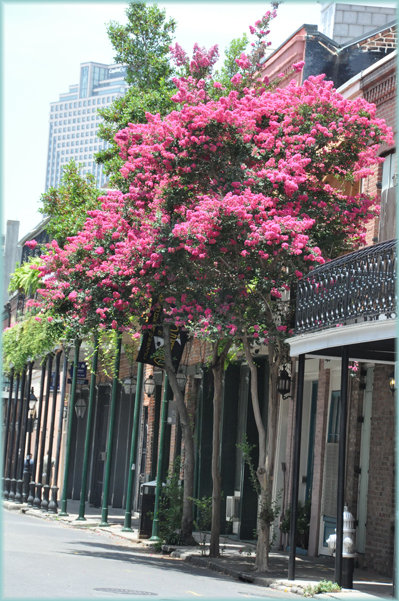 (Lagerstroemia indica) that adorned the city's streets and gardens.
(Lagerstroemia indica) that adorned the city's streets and gardens.
The French Quarter
First Stop: Bourbon Street
Our accommodations were in the historic French Quarter, a short trolley ride from the nearby Garden District. It seemed natural to start our New Orleans sight seeing at the historic landmark--Bourbon Street--since it is located in the French Quarter. A favorite of the world, Bourbon Street became the city's hub in 1718.
Be prepared if you're planning to take your children, prudish mother or grandmother for a walk down Bourbon street. There are some noteworthy shops and restaurants, but for the most part you may see bars, sex shops and people who had a few too many (at least they did the day we visited). Relief came as we turned the corner and saw families, horse and carriage rides and fine antique shops lining Royal Street, a block away.
The city's charm continued on the other nearby streets, along with tours, shops, restaurants, Jackson Square, River Walk, Harrah's Casino and other New Orleans attractions, including The French Market.
The French Market
The French Market is America's oldest open air market, featuring T-shirts, souvenirs, jewelry, food, produce and a small garden shop. In the garden shop we found different varieties of cacti and four colors of Plumeria (Plumeria rubra). Our June visit coincided with the harvest of southern Louisiana's Creole tomatoes, which chefs were quick to feature on their menus.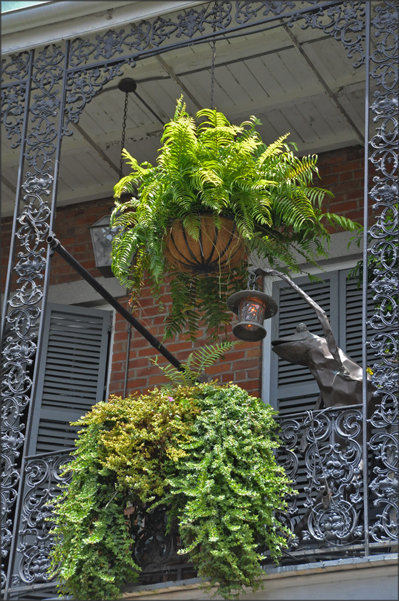
Aside from the renowned Cajun cuisine, art and jazz found in the French Quarter, my absolute favorite attraction was the ornate, decorative iron works that embraced the balcony and verandah gardens.
NOLA Balcony Gardens
The magnificent style of the cast iron can be found on ornate, decorative iron works surrounding balcony and verandah gardens throughout the French Quarter, truly historic treasures unique to the city. In New Orleans, the cast iron industry started in 1825 when Leeds Iron Foundry was established.[1] Large quantities of decorative railings, gates, garden tables and chairs, fountains and other cast iron products were produced, especially in the 1850s. High production meant plenty of jobs for ironworkers such as founders, blacksmiths, pattern makers and moulders, which flourished up until the Civil War. Ornamental ironwork has a long history of tradition in New Orleans.
We viewed many beautiful garden hanging baskets cascading from the decorative balconies.
NOLA Blooms
It was difficult to identify some of the balcony plantings because they were so high up; we did notice plenty of ferns, tropical hibiscus and Mandevilla splendens. Agapanthus, live oaks, palms, elephant ears, flowering banana and gingers are just a few more of the over 500 plant species reported on Dave's Garden to grow well within 20 miles of New Orleans. 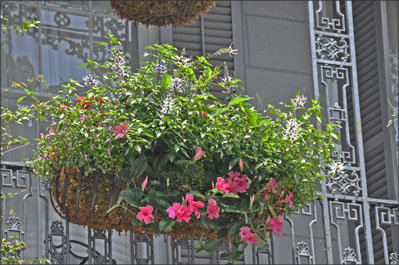
Tropical Bell Agapanthus (Agapanthus campanulatus) were growing and blooming everywhere. Live oaks (Quercus virginiana) were seen throughout the city too, gracing garden style courtyards, while providing cool shade from their wide arching spread. We dined at the Court of Two Sisters, located in the French Quarter (thanks to a traveler's recommendation) and found their garden decor, iron tables, and a tranquil wishing well fountain made for an enchanting outdoor garden dining room beneath the Live oak canopy. The trees were decorated with mini white lights that sparkled above, while a few pigeons nibbled below, scavenging for fallen crumbs.
The Garden District
Originally built in the 1800s, the historic Garden District is very accessible by trolley (street-car) public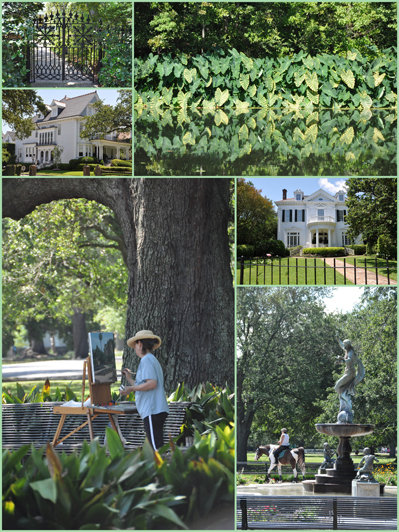 transportation. Famous residents have included Anne Rice, John Goodman and Trent Reznor. Trolley public transportation is found throughout the city and makes travel affordable and easy without renting a car. The trolley fare was $1.25 per ride - not bad for a ride on the oldest operating street-car rail line in the world.
transportation. Famous residents have included Anne Rice, John Goodman and Trent Reznor. Trolley public transportation is found throughout the city and makes travel affordable and easy without renting a car. The trolley fare was $1.25 per ride - not bad for a ride on the oldest operating street-car rail line in the world.
After the wrath of Hurricane Katrina in 2005 the streetcars were out of operation until 2007, when they resumed service. Tourists and residents can again ride the St. Charles Ave. street-car past tree-lined, elegant, historic mansions and restaurants all the way to Audubon Park. Audubon Park attracts artists, equestrians, and many area residents and visitors. Its waterways, lined with moisture-loving, giant elephant ears (Colocasias), are home to many species of birds. The park includes a 1.8 mile jogging track, premier public golf course, zoo, playground, and tranquil gardens. Here too, beautiful iron work can be seen along the residential areas outside the park, framing natural growing caladiums along the walkways.
The Garden District did not have the severe devastation by Hurricane Katrina as some areas experienced, but still flooding and roof damage affected many, including the famous restaurant (est.1880) Commander's Palace, which was forced to close for 13 months for renovations. Chef's Paul Prudhomme and Emeril Lagasse both launched their careers at Commanders. Today, Commander's executive chef, Tory McPhail, creates delicious Creole cuisine - one of the many culinary highlights of our stay, along with the tour of their kitchen.
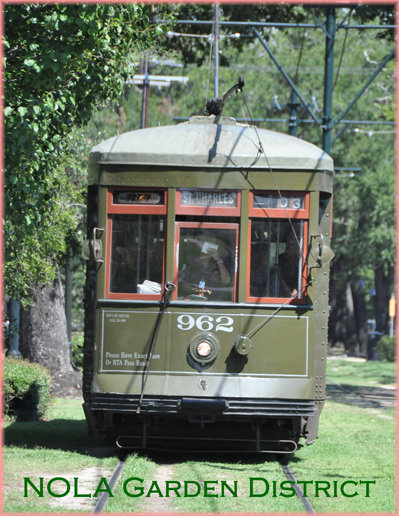
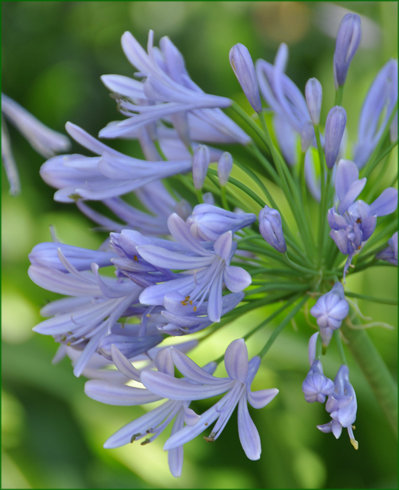
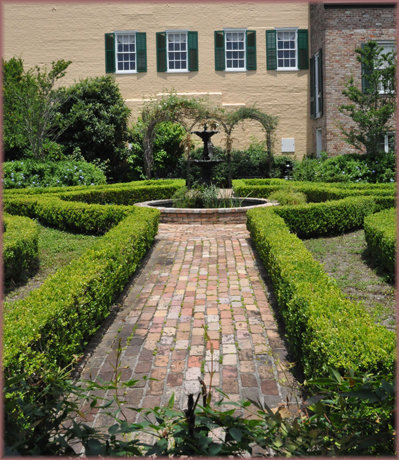
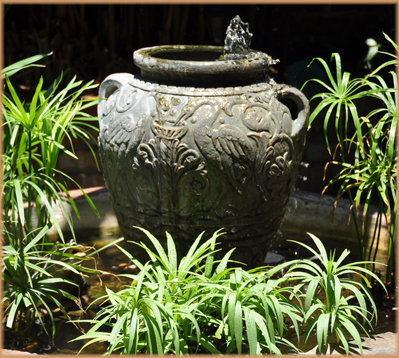

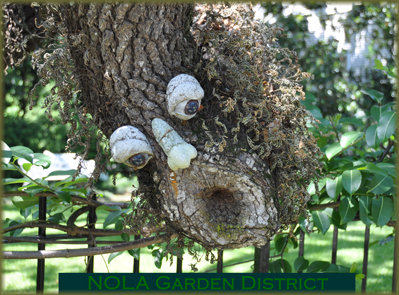
NOLA Sights
There are so many things to do and see in New Orleans. Other points of interest include Plantation & Swamp tours, Beauregard-Keyes House, Cemetery Tours, Old Ursuline Convent, City Park Botanical 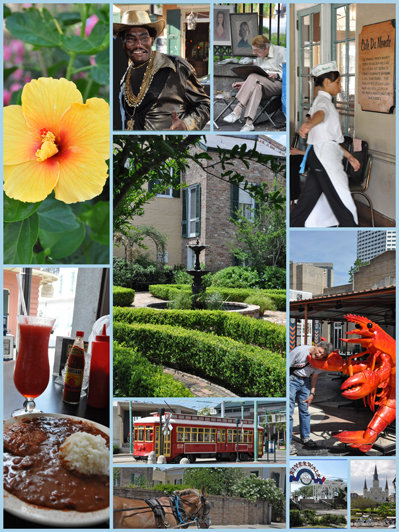 Garden and Longue Vue House & Gardens.
Garden and Longue Vue House & Gardens.
For us, the New Orleans Voodoo Cemetery Tour of the legendary St. Louis Cemetery #1, began with a sighting of -- not a ghost! -- but of my favorite, variegated shell ginger (Alpinia zerumbet 'Variegata'), in a small garden courtyard nearby a fountain. We tanked up and hydrated with water, after we heard a woman had passed out on the last tour from the heat and were glad we did: the concrete in the cemetery made it feel even hotter. We had fun on our daytime adventure into the oldest City of the Dead. And on the way to the Voodoo Cultural Center, we saw ornamental, flowering banana trees (shown) thriving in the heat of full sun.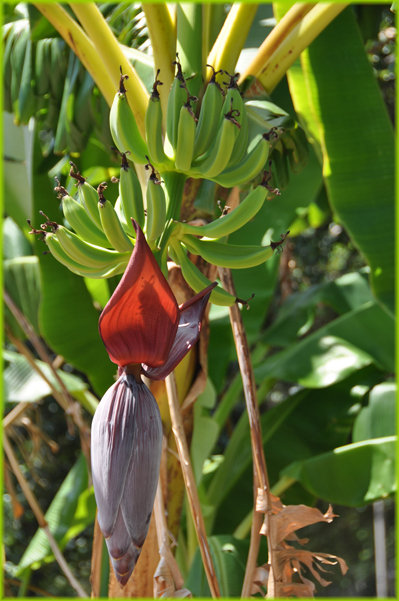
The Old Ursuline Convent is the oldest building (1752) in the Mississippi Valley. It is located at 1100 Chartres Street in the historic French Quarter and features a formal garden at the entrance and an herb garden in the back of the convent. The garden was featured on "Victory Garden" on PBS. For more information call (504) 529-3040.
City Park was hit hard from Hurricane Katrina and is back open, welcoming continued support and visitors. The Botanical Garden is located within City Park. Directions are given on their web site. You can get there from downtown by taking public transportation. City Park also features activities for children, golf, and birding.
We heard about Longue Vue on a trolley ride from a friendly New Orleans resident who said it was beautiful and well worth a visit. For admission fee and more information, visit their web site or call (504) 488-5488.
Longue Vue Video:
Please keep in mind that there is much more to
Metropolitan New Orleans than the few areas mentioned here.
If you know of other notable garden areas in New Orleans, please update our itineraries by posting a comment.
Congratulations New Orleans Saints ~ 2010 Super Bowl XLIV champions for the first time in their 43-year history.
[1] Masson A.M., Schmalz L.H., Cast Iron and the Crescent City, 1995 Louisiana Landmarks Society, New Orleans
Related Articles:
The Branches of Memory.... The Southern Live Oak by Jeannette Adams
Related Books ~ Dave's Garden Bookworm:
Louisiana Gardener's Guide by Dan Gill & Joe White
Guide to Louisiana Vegetable Gardening by Felder Rushing & Walter Reeves
Related Links:
LSU AgCenter.com
BigEasy.com
Audubon Nature Institute
New Orleans online.com
(Editor's Note: This article was originally published on August 19, 2009.Your comments are welcome, but please be aware that authors of previously published articles may not be able to promptly respond to new questions or comments.)
Copyright © www.100flowers.win Botanic Garden All Rights Reserved